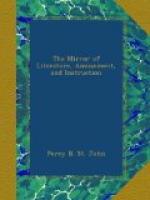miles through, and is rather to be considered the model
of a town, than one in itself. In fact, it is
merely an Italian villa, or properly, a collection
of villas; and the extreme smallness of what we may
justly term the citizens’ boxes, is another
source of astonishment to those who have been used
to contemplate Roman architecture in the magnificence
of magnitude. Pompeii however, must always interest
the intelligent observer, not more on account of its
awful and melancholy associations, than for the opportunity
which it affords, of remarking the extreme similarity
existing between the modes of living then,
and now. “’Tis Greece, but living
Greece no more!” for in truth, we are enabled
to surmise, from the relics of this buried and disinterred
town, that manners and customs, arts, sciences, and
trades, have undergone but little change in Italy since
the period of its inhumation until now. In Pompeii,
the shops of the baker and chemist are particularly
worthy of attention, for you might really fancy yourself
stepped into a modern bottega in each of these;
but, the museum of Naples, wherein are deposited most
of the articles dug from Pompeii, Herculaneum, and
Paestum, is a most extraordinary lion, and one which
cannot fail to affect very deeply the spectators;
there you may behold furniture, arms, and trinkets;
and the jewellery is, I can assure you, both in materials,
pattern, and workmanship, very similar indeed to that
at present in fashion, and little injured by the lapse
of years, and the hot ashes under which it was buried.[2]
There too, you may behold various domestic and culinary
utensils; and there it is quite curious to observe
various jars and bottles of fruits, and pickles, evidently
preserved then, the same as they are by our notable
housekeepers now; of course they are blackened and
incinerated, nevertheless, the forms of pears, apples,
chestnuts, cherries, medlars, &c. &c. are still distinguishable.
Very little furniture has been found in Pompeii; probably,
because it was only occasionally resorted to as a
place of residence, like our own summer haunts of the
drinkers of sea and mineral waters; or, the inhabitants
might have had warning of the coming misfortune, and
conveyed most of their effects to a safer place; a
surmise strengthened by the circumstance of so few
human skeletons having been found hitherto in the
town; in the museum, however, is a specimen of the
inclined couch or sofa, used at meals, with tables,
and other articles of furniture. The method of
warming apartments by flues, and ventilating them,
as now practised, was known to the inhabitants of
Pompeii. Of this town, amongst public buildings,
the Forum, the Theatre, and the Temple of Isis, have
been discovered; and the latter has revealed, in a
curious manner, the iniquitous jugglery of the heathen
priests. The statue of Isis, was, it seems, oracular,
and stood on a very high pedestal, or kind of altar
in the temple of the goddess. Within this pedestal




